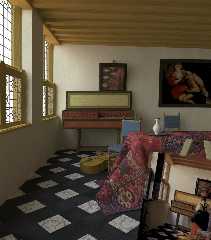|
 |
...his painting, the canvas is not even dry and the artist and his models
went out for dinner.
Well, but the raytraced reproduction is far away from being finished.
This is just the first test with HQ radiosity settings.
global_settings {
assumed_gamma 1.0
max_trace_level 16
radiosity {
count 1600
error_bound 0.15
recursion_level 4
...
[everything else is the same as the indoor HQ settings from rad_def.inc]
The problems are:
Some ugly bright spots on the walls. Especially near the virginals and
windows. They appear ONLY when layerd textures are used. Indeed
the top layer uses an agate pigment and the shape of these spots is similar
to that pattern but in fact due to the pattern, these parts should appear
a little bit darker than the surrounding.
When using some glass material for the windows (indeed for this render
there is no glass used) even a very simple glass, the wall at the window side
becomes completely black. To be more exact, the part of the wall facing
the room.
The image maps (used for the paintings) become sudden black at a certain
level of darkness. So they look very ugly and be sure, the original maps I
have used are smooth.
All above mentioned does not appear with lower quality settings for radiosity
(e.g count 400, error_bound 0.8) and also not when using normal light sources.
Have I missed something?
Or are these known limitations for the way radiosity is done by POV?
Or is there something goin' wrong with the radiosity samples calculated
by POV (in other words: are there BUGS)?
Has anybody of the more experienced radiosity users any hints, explanations
or whatever? I'm really stuck and with HQ radiosity the image needs days
to render so it's no fun to work with trial and error.
And here is something completely different but quite interesting.
For this image you are standing close to the rear wall behind the place Vermeer
was sitting, so you can see the easel. The dimension for the room was reconstructed
by what can be seen in the mirror. (In the original painting you see the edge of the
table, so you can calculate the angle the mirror is hanging on the wall and
you can also see the part where the rear wall meets the floor and now you can
calculate the length of the room.) So we know the length of the wall at the window
side and we see that there is exactly room for a third window of the same size as
already seen in the painting. Also I assume that Vermeer would not have placed
his easel in the darkest place of the room and there it would be if there is not a
third
window.
BUT the lighting as seen in the painting (especially on the rug covering the table)
looks more like there is NOT a third window. (Or lets say the window shades
are closed.) In the image I have attached there is a third window but I have also
done a radiosity simulation without the third window and the lighting is much closer
to what can be seen in the painting.
What does this mean? Has Vermeer closed the window shades because he preferred
this kind of lighting for the room even if this means his canvas was lit very poor?
Or did he close the window shades, looked at the room, opened them to do some
brush strokes, closed them again...
-Ive
Post a reply to this message
Attachments:
Download 'MusicLesson.jpg' (75 KB)
Preview of image 'MusicLesson.jpg'

|
 |




![]()